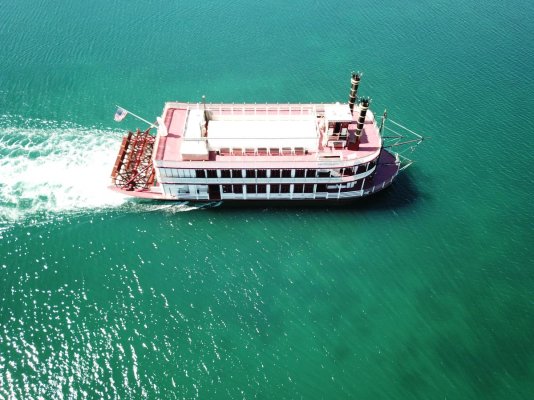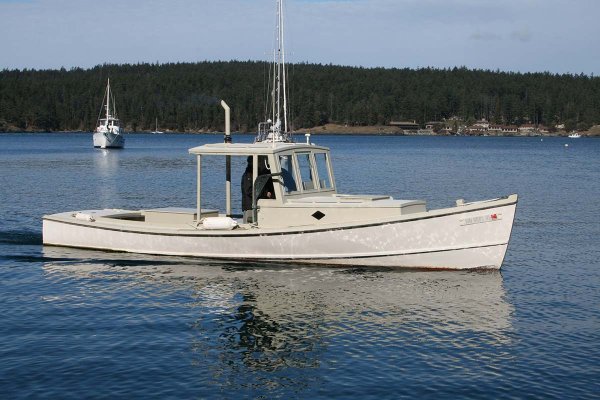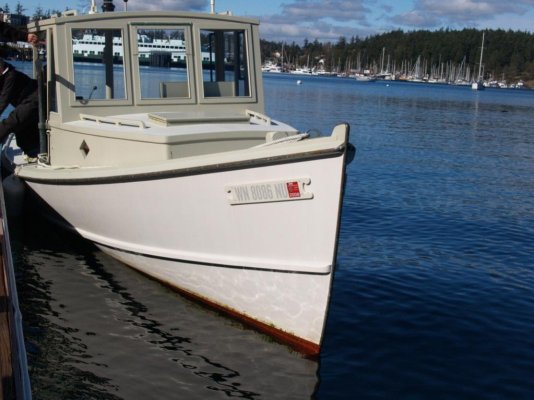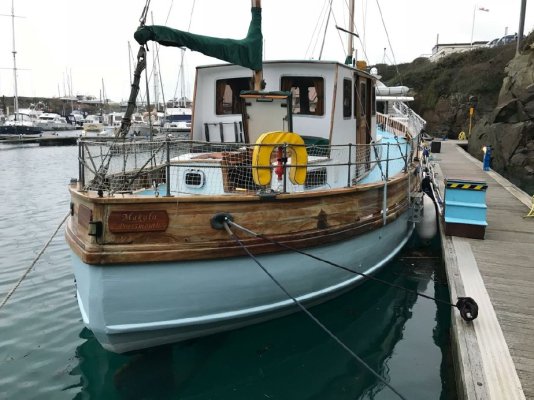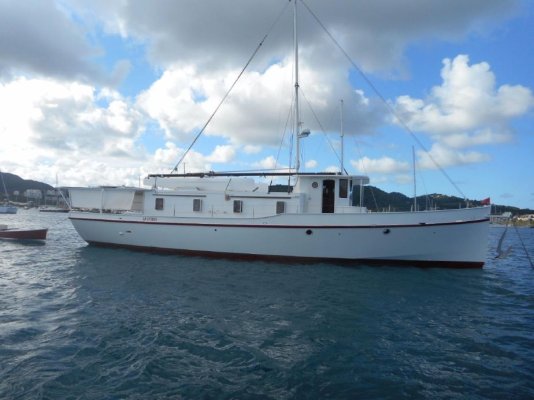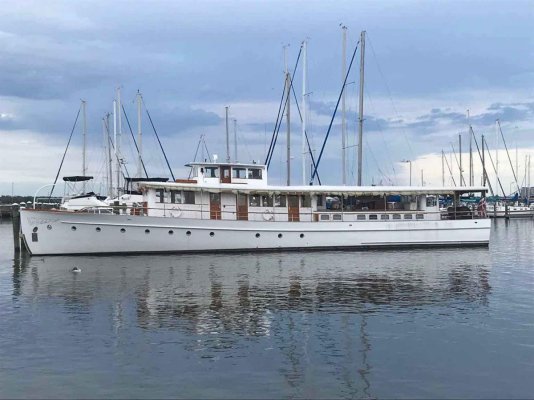You are using an out of date browser. It may not display this or other websites correctly.
You should upgrade or use an alternative browser.
You should upgrade or use an alternative browser.
Interesting boats
- Thread starter Steve
- Start date
The friendliest place on the web for anyone who enjoys boating.
If you have answers, please help by responding to the unanswered posts.
If you have answers, please help by responding to the unanswered posts.
O C Diver
Guru
- Joined
- Dec 16, 2010
- Messages
- 13,178
- Location
- Fort Myers, Florida
- Vessel Name
- End Of The Line
- Vessel Make
- Trinka 10 Dinghy
I think you need more research on this one Eric. A good read is Alan Vaitses book "covering Wooden Boats with fiberglass" written in the early 80's by a boatyard owner. He pioneered wood boat covering with polyester fiberglass...He went against Owens Corning ,broke the rules and had many large and small yachts, fishboats , and workboats. His philosophy was that done right (mechanically fastened in the "green" stage, these FG coverings were as strong as the wood underneath. Way stronger than the epoxy folks treatments, dom
ne his way. As for adding weight, yes it did..but added usually more buoancy because it displaced water due to thickness. Ballast added in some cases. Interesting read that contradicts popular opinion . Whether you agree or disagree, read the book and see many examples of nice boats that have had there life extended for reasonable amounts of money. A Very good read. He is kind of like George Buehler, contrarian. RIP George.
For the Diesel Ducks built out of wood, a number were glassed on the hull during construction. I believe George covered that in one of his boat building articles.
Ted
O C Diver
Guru
- Joined
- Dec 16, 2010
- Messages
- 13,178
- Location
- Fort Myers, Florida
- Vessel Name
- End Of The Line
- Vessel Make
- Trinka 10 Dinghy
The boatyard where I haul out, has glassed or epoxied a number of Chesapeake Bay work boats and at least one of the skipjacks. Any poor condition boards are replaced. The hull is allowed to dry out for several months and then it's sandblasted to remove any coatings and ruff up the surface. The covering of choice is 2 layers of bi-axial cloth with West system epoxy. It is amazing how stiff if makes an old wood boat. Most of the watermen like the feel and handling of a wood boat. The reduced maintenance of a glass bottom is hard to beat.
Ted
Ted
The boatyard where I haul out, has glassed or epoxied a number of Chesapeake Bay work boats and at least one of the skipjacks. Any poor condition boards are replaced. The hull is allowed to dry out for several months and then it's sandblasted to remove any coatings and ruff up the surface. The covering of choice is 2 layers of bi-axial cloth with West system epoxy. It is amazing how stiff if makes an old wood boat. Most of the watermen like the feel and handling of a wood boat. The reduced maintenance of a glass bottom is hard to beat.
Ted
Ted
You're making me question my [many decades old] negative feelings about cold lam applications/outcomes. Experiences I had in boat yards on LI NY were back in 1960's. I imagine materials and installation-method technology in general has much improved glass applications over a hull's wood.
I should probably do a google search and read up on things. That said - I'm in no rush to learn details as I don't expect to being entailed with cold lam in the future.
McGillicuddy
Guru
- Joined
- Dec 4, 2015
- Messages
- 754
- Location
- USA
- Vessel Name
- Scot Free
- Vessel Make
- Cheoy Lee 53' Efficient
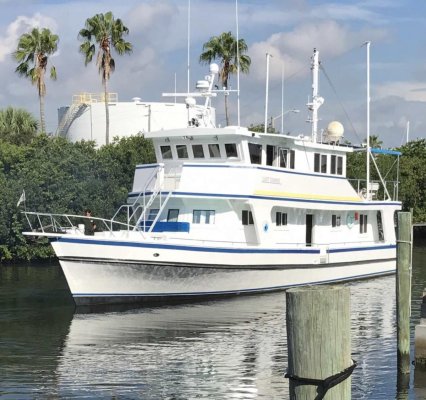
This is a wooden Chesapeake head boat now with C-Flex sheathing. Has been converted to a private yacht, now owned by a friend of mine. I have been through the interior of the wooden hull, dry, sound condition, near perfect. Driven by a pair of Detroit 6-71N’s. Nice economic cruising at 8 knots on a 70’ Boat.
Nomad Willy
Guru
Thanks Jack,
Yup there’s lots of opinions on FG over wood and mine is just one opinion.
On plywood boats FG sheathing can be very effective and good for rocky beach landings or river work.
But for general purpose boats FG covering is all negative ....... IMO. Especially planked boats. Wood expands and contracts. FG basically dosn’t. The sheer forces causes failed adhesion. Wood boats “work” too so the breakdown just keeps getting worse. But with the right kind of wood, the right width of planks and the right surface prep a good FG sheathed wood boat possibly be made.
Yup there’s lots of opinions on FG over wood and mine is just one opinion.
On plywood boats FG sheathing can be very effective and good for rocky beach landings or river work.
But for general purpose boats FG covering is all negative ....... IMO. Especially planked boats. Wood expands and contracts. FG basically dosn’t. The sheer forces causes failed adhesion. Wood boats “work” too so the breakdown just keeps getting worse. But with the right kind of wood, the right width of planks and the right surface prep a good FG sheathed wood boat possibly be made.
Sailor of Fortune
Guru
Thanks Jack,
Yup there’s lots of opinions on FG over wood and mine is just one opinion.
On plywood boats FG sheathing can be very effective and good for rocky beach landings or river work.
But for general purpose boats FG covering is all negative ....... IMO. Especially planked boats. Wood expands and contracts. FG basically dosn’t. The sheer forces causes failed adhesion. Wood boats “work” too so the breakdown just keeps getting worse. But with the right kind of wood, the right width of planks and the right surface prep a good FG sheathed wood boat possibly be made.
I can appreciate your position Eric. If you read the book, I think your eyes will be opened a little. Heavily planked wooden yachts and fishing boats that have new life. They don't suffer from your "expand and contract" scenario. Maybe something to learn other than anchors here?
View attachment 73782
This is a wooden Chesapeake head boat now with C-Flex sheathing. Has been converted to a private yacht, now owned by a friend of mine. I have been through the interior of the wooden hull, dry, sound condition, near perfect. Driven by a pair of Detroit 6-71N’s. Nice economic cruising at 8 knots on a 70’ Boat.
Would love to see interior picts!
MurrayM
Guru
Bit of thread drift here, but C-Flex is also interesting in that new 'one-off' fibreglass hulls can be made without a mold;
Boat Building in C-Flex Glass - Fine Line Boat Plans & Designs
http://seemanncomposites.com/cflex.htm
C-Flex fibreglass planking has been developed to make it possible to build a fibreglass boat without a traditional mold. All that is needed is a lightweight framework. In some the bulkheads and other frames which are usually fitted in the boat later can be used as part of the framework that you build the boat over.
This combination of rigid rods held together loosely, with pliable areas in between , is what makes C-Flex unique in construction materials. In our knowledge, it is the only self-supporting material available today which will conform to compound curves without having to be stretched or deformed in some way. Furthermore, C-Flex will bend sideways, a property which virtually eliminates the problem of having to fit or spile the ‘planks’. Most boats can be built by starting the first ‘plank’ parallel to the sheer line then butting the next ‘plank’ right alongside all the way to the keel.
Aside from the obvious advantage of being able to build an all fibreglass boat without a mold, C-Flex also affords the designer and builder the opportunity to save weight over a conventional fibreglass laminate without sacrificing strength.
This is because C-Flex is an unidirectionally reinforced material and is considerably stronger in the direction of it’s fibre orientation (lengthwise) than an ordinary fibreglass mat or woven roving laminate.This property is used to save weight in the hull shell by running the C-Flex along the lines of anticipated greatest stress (usually fore and aft).
The weight savings also translate into a cost savings. Even though the C-Flex itself costs more per pound than mat or woven roving, the completed hull shell will cost about the same as a hull built with just mat and woven roving. The advantages of being able to build without a mold and the weight savings are a bonus.
Boat Building in C-Flex Glass - Fine Line Boat Plans & Designs
http://seemanncomposites.com/cflex.htm
Last edited:
dhmeissner
Guru
- Joined
- Sep 26, 2012
- Messages
- 1,569
- Location
- North America
- Vessel Name
- The Promise
- Vessel Make
- Roughwater 35
Attachments
Nomad Willy
Guru
Hey Dave that’s a real boat. I’d like it OB.
I’ve seen the boat before but can’t recall her bottom. Think she’s V.
I’ve seen the boat before but can’t recall her bottom. Think she’s V.
dhmeissner
Guru
- Joined
- Sep 26, 2012
- Messages
- 1,569
- Location
- North America
- Vessel Name
- The Promise
- Vessel Make
- Roughwater 35
Hey Dave that’s a real boat. I’d like it OB.
I’ve seen the boat before but can’t recall her bottom. Think she’s V.
Yes Eric, I found that surfing the net...I’d love to see it up close. A lot of history to that as well.
OldDan1943
Guru
- Joined
- Oct 2, 2017
- Messages
- 10,617
- Location
- USA
- Vessel Name
- Kinja
- Vessel Make
- American Tug 34 #116 2008
I spent some time looking at the catalog. They do have some pretty boats.
Early 70's in Camden. Rockport and Rockland ME, when I owned a rowdy-patron restaurant tavern in Camden: For various reasons... [some was flat out days of hard ass, trap pulling lobstering - some was great island parties with my lobstermen buddies]... I was aboard numerous Lobster boats just like that.

2000 single digit years we spread both mom and dad's ashes into Penobscot Bay... off a lobster tour boat!

McGillicuddy
Guru
- Joined
- Dec 4, 2015
- Messages
- 754
- Location
- USA
- Vessel Name
- Scot Free
- Vessel Make
- Cheoy Lee 53' Efficient
Would love to see interior picts!
Not that interesting on the inside really. Has a centerline stairway that really chops up the space badly. Paneling is standard Home Depot pressed wood stuff. It’s well enough done, just not my cup of tea or ‘yacht’ quality. The previous owner could have done a much better job on design and execution but I think he followed a commercial fishing boat mentality.
Machinery space is spacious though. Plenty walk around room. Has a 30kW genny that is way enough for the boat.
Still my buddy bought it right and for the price he paid has a very capable boat. He is heading down to the Caribbean with it soon.
ben2go
Guru
Bit of thread drift here, but C-Flex is also interesting in that new 'one-off' fibreglass hulls can be made without a mold;
Boat Building in C-Flex Glass - Fine Line Boat Plans & Designs
http://seemanncomposites.com/cflex.htm
FRP = fiberglass reinforced plywood or wood of any kind. It's becoming very popular in the quick and dirty DIY plan built boats. If I get to build mine, it will be plywood skin on frame and encapsulated in fiberglass and epoxy for waterproofing.
Nomad Willy
Guru
Plywood reinforced fiberglass is much more common and makes more sense as the plywood is strong and most importantly for boats stiff. So most often the plywood makes the fiberglass usable on the boat. But of course the same weight of wood is much stronger than traditional reinforced plastic.
Last edited:
Al
Guru
- Joined
- Apr 1, 2012
- Messages
- 2,206
- Location
- usa
- Vessel Name
- 'SLO'~BELLE
- Vessel Make
- 1978 Marben-27' Flybridge Trawler(extended to 30 feet) Pilothouse Pocket Cruiser[
Plywood reinforced fiberglass is much more common and makes more sense as the plywood is strong and most importantly for boats stiff. So most often the plywood makes the fiberglass usable on the boat. But of course the same weight of wood is much stronger than traditional reinforced plastic.
Eric may have in his days up here, spotted older boats that had been plywooded over due to age. I have for sure. Looking back now or even if younger looking for a challenge, finding the hull shape in poor condition, sheving in 1/4 in one side clear exterior plywood and then c-flex may provide One: strength to an old hull with the structural inherited strength of plywood, a smooth surface for the C-Flex. I would not think the added weight a bad thing, as it would add a bit of ballast effect.
 Damn, old age is coming at a bad time!!
Damn, old age is coming at a bad time!!
Attachments
Simi 60
Guru
- Joined
- Jul 1, 2016
- Messages
- 5,482
- Location
- Australia
- Vessel Make
- Milkraft 60 converted timber prawn trawler
FRP = fiberglass reinforced plywood or wood of any kind. It's becoming very popular in the quick and dirty DIY plan built boats. If I get to build mine, it will be plywood skin on frame and encapsulated in fiberglass and epoxy for waterproofing.
It was becoming popular in the 60s 70s
80s was strip plank, usually western red cedar sandwich with double bias and or uni cloth and epoxy on either side.
80s to 90s saw foam, and balsa also used as a sandwich
Now its the same as the 80s and 90s but throw in kevlar/carbon/basalt fibres and nomex and nidaplast cores.
Last edited:
Simi 60
Guru
- Joined
- Jul 1, 2016
- Messages
- 5,482
- Location
- Australia
- Vessel Make
- Milkraft 60 converted timber prawn trawler
Been looking at this one for awhile now..
Wester red cedar strip plank sandwich
Nice
2003 Ang Trawler 56, Martinique - boats.com
McGillicuddy
Guru
- Joined
- Dec 4, 2015
- Messages
- 754
- Location
- USA
- Vessel Name
- Scot Free
- Vessel Make
- Cheoy Lee 53' Efficient
OldDan1943
Guru
- Joined
- Oct 2, 2017
- Messages
- 10,617
- Location
- USA
- Vessel Name
- Kinja
- Vessel Make
- American Tug 34 #116 2008
View attachment 73962
This showed up at the Marina in Long Beach MS last week. Reportedly a 1929 Trumpy. New Owner took delivery about 10 days ago in La. I couldn’t find it on yachtworld. Les Bon Temps Roulez. (The Good Times Roll)
Hull is sheathed with C-Flex.
What was the approx length? 80Ft?
OldDan1943
Guru
- Joined
- Oct 2, 2017
- Messages
- 10,617
- Location
- USA
- Vessel Name
- Kinja
- Vessel Make
- American Tug 34 #116 2008
Some of these old boats look like prime material for movie sets.
Nomad Willy
Guru
Dan I’d estimate well over 80 feet.
Perhaps 115’
Perhaps 115’
OldDan1943
Guru
- Joined
- Oct 2, 2017
- Messages
- 10,617
- Location
- USA
- Vessel Name
- Kinja
- Vessel Make
- American Tug 34 #116 2008
Dan I’d estimate well over 80 feet.
Perhaps 115’
No doubt. It has fine lines. Sadly we will never see the interior.
I'll bet it is beautiful inside. Lots of nice wood.
That's the kind of boat that make the crew wear iron white uniforms.
A long boat with a relatively narrow beam.
McGillicuddy
Guru
- Joined
- Dec 4, 2015
- Messages
- 754
- Location
- USA
- Vessel Name
- Scot Free
- Vessel Make
- Cheoy Lee 53' Efficient
I don’t know. Someone(at the marina) said it was 70’. Looks longer to me. It’s the T head at the end of my pier. I will go pace it off tomorrow.
Similar threads
- Replies
- 0
- Views
- 1K
- Replies
- 20
- Views
- 3K
Latest posts
-
-
-
-
-
-
-
-
For Sale: Custom dog stairs for Beneteau Swift Trawler 44
- Latest: Wrong Harbor Harry
-
-

